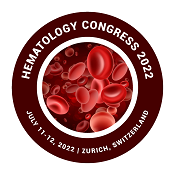
Alireza Goodarzi
Hamadan University of Medical Sciences, Iran
Title: Heparin-Induced Thrombocytopenia among Patients with Severe Acute Respiratory Syndrome Coronavirus 2 (SARS-CoV-2) Infection
Biography
Biography: Alireza Goodarzi
Abstract
Introduction: Heparin-induced thrombocytopenia (HIT) is a life-threatening complication. Recently, HIT has been reported as a factor in exacerbating thrombocytopenia in COVID-19. Despite studies, the role of HIT in the development of thrombotic disorders and its mortality in COVID-19 patients is limited. In the present study, we assessed the incidence of HIT in patients with COVID-19.
Patients and methods: This cross-sectional descriptive study was performed on 97 COVID-19 patients in Yasuj City (Southwest Iran). Demographic factors and platelet count, PT, aPTT, and D-dimer were recorded and checked at admission and during hospitalization. Anti-Heparin-PF4 antibody assay was performed for all eligible patients. Statistical significance was based on two-sided design-based tests evaluated at the 0.05 level of significance. All the statistical analyses were performed by SPSS 20 software.
Results: Most of the patients (n= 57, 58.8%) were male. The mean age of the patients was 55.46 ± 15.2 years, and the mean hospitalization was 17.57 ± 7.2days. The mean platelet count at admission (in all patients) was 209.9 ± 79.8. The results of the Anti-Heparin-PF4 antibody assay showed that 9.3% (n =9) of the patients were positive for heparin PF4 antibody (HPA). The mortality rate was higher in HPA- positive.
Conclusion: Although the true frequency of HIT in this study was unclear, it can be concluded that HPA is a potential complication for COVID-19, with a high rate of morbidity and mortality. Further confirmatory studies are required to address amities of the present study.

